Though the home construction industry has evolved slowly, new technologies are emerging that will likely revolutionize how houses are built. One such innovation is 3D printing, which has the potential to transform the construction industry, by providing a range of benefits and valuable applications.
From crafting intricate interior design elements with 3D printers to shaping entire home structures, 3D printing technology is showing early promise of redefining the way homes are conceptualized, designed, built and maintained.
Whether you’re searching for affordable housing or seeking an innovative builder for your perfect home, learning about the possibilities of 3D-printed homes will help you understand where state-of-the-art home building is headed.
In this article, we explore the current state of 3D printed homes, giving you a comprehensive understanding of this emerging technology and what it means for the future of innovative home building.
Table of Contents
- What is 3D Printing?
- How Does a 3D Printer Build a Home?
- Advantages of 3D-Printed Homes
- Disadvantages of 3D-Printed Homes
- 3D Printed vs. Prefabricated Homes
- The Future of 3D Printing in Construction
- 3D Construction Printing Resources
Also see:
What is 3D Printing?
3D printing, also known as additive manufacturing, is a technology that uses digital models to fabricate three-dimensional objects, one layer at a time. Though conceptualized earlier, 3D printing technology really came into being in the 1980s, and since then, has evolved into a versatile tool with applications spanning various industries.
The process typically begins with a computer-aided design (CAD) file, which is then sliced into cross-sectional layers. A 3D printer then deposits material, ranging from plastics and metals to ceramics, one layer at a time, gradually building the object.
This additive approach enables design freedom, customization, and cost-efficiency to levels previously thought unattainable, making 3D printing an emerging cornerstone of modern manufacturing, prototyping, and even medical advancements.
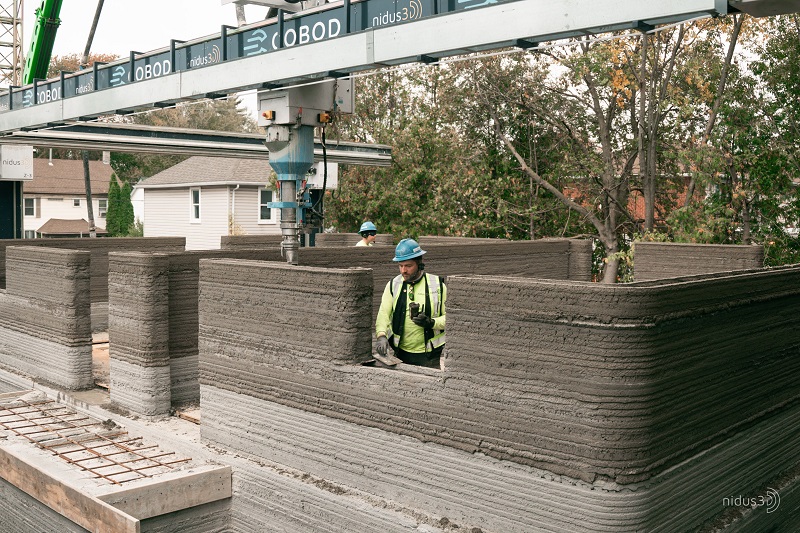
A COBOD 3D printer in action by Nidus 3D in Canada
Within the residential construction industry, at its core, 3D printing involves a printer with a nozzle that deposits building material layer by layer, following a blueprint to create the structural walls of a desired house. This process allows traditional construction methods, such as on-site assembly, studs, drywall, electrical wiring, and plumbing, to be incorporated into the 3D printing process.
3D-Printed Home by ICON at 17 Street Residences, Austin, Texas
Companies such as COBOD, ICON and Mighty Buildings have made significant contributions to the advancement of 3D printing technology for the residential construction industry. Keep in mind that there are many companies advancing 3D printing technologies, as well forward-looking home builders that are learning how to use these solutions to build homes that homebuyers want and need.
Within other architectural applications, 3D printing and 3D scanning have also emerged as critical new technologies used to restore historic homes. These capabilities allow preservationists to replace or repair historic design elements, such as ornate pieces on building facades, accurately and cost-effectively.
Also see:
How Does a 3D Printer Build a Home?
The process of building a home via 3D construction printing (3DCP) is nothing short of an incredible feat of modern technology. A robotic-enabled 3D printer deposits material in layers, following a pre-programmed design to build up the structural walls of a ground floorplan at a consistent pace for proper curing.
HN TimeLapse NEXCON 3D Construction Printing-Tiny Home
3D construction printers use concrete or a specially mixed material to construct the exterior and interior walls, while traditional building methods are used for other areas of the home. Interior finishes, plumbing, electrical wiring, and insulation are done with the same materials as traditional homes.
100 Home 3D-Printed Community By ICON + Lennar + Co-designed by BIG
Investment in firms making 3D-printed homes and 3D printing technologies has grown as a means to tackle the housing shortage issue due to the affordability and efficiency of the underlying methods used. In short, 3d printing technology could be one of the most important new innovations in home building as a key component of wide-ranging efforts to decrease construction costs while increasing overall efficiencies.
Also see:
Advantages of 3D-Printed Homes
Let’s delve into the advantages of owning a 3D printed home and why this technology is gaining popularity in the construction industry. As you’ll see, the benefits of 3D printing construction are often intertwined and interrelated.
- Reduced Costs
- Speed and Efficiency
- Sustainability and Eco-Friendliness
- Improved Structural Integrity
- Increased Customization
- Reduced Labor Requirements
Reduced Costs
One of the major advantages of building a 3D printed home is its cost efficiency. The construction process of a 3D printed home reduces labor costs, as less on-site skilled-labor is required. Additionally, the use of additive manufacturing technology minimizes material waste, saving money in the process. The faster construction time associated with 3D printing technology also translates to lower overall costs for homeowners, as it further reduces billable labor hours. With these cost-saving benefits, 3D printing technology definitely has the potential to make housing more affordable in the future.
Speed and Efficiency
The speed and efficiency of building a 3D printed home are unmatched by traditional construction methods. 3D printing technology enables rapid construction, significantly reducing building time. The assembly time for a 3D printed home is much quicker compared to traditional methods, as construction site preparation is simplified, leading to faster project completion.
Moreover, the precision of 3D printing technology ensures accurate construction, minimizing errors and saving time for construction companies. With increased efficiency, construction companies can complete more projects in less time, meeting the high demand for housing. Since 3D printing reduces the need for scarce skilled labor, the technology has the potential to alleviate the housing shortage.
Sustainability and Eco-friendliness
In an era where sustainability is a pressing concern, 3D printing technology offers an eco-friendly approach to construction. Unlike traditional construction methods (e.g. stick-built wood framing), 3D printing technology produces less waste, reducing the environmental impact and conserving resources.
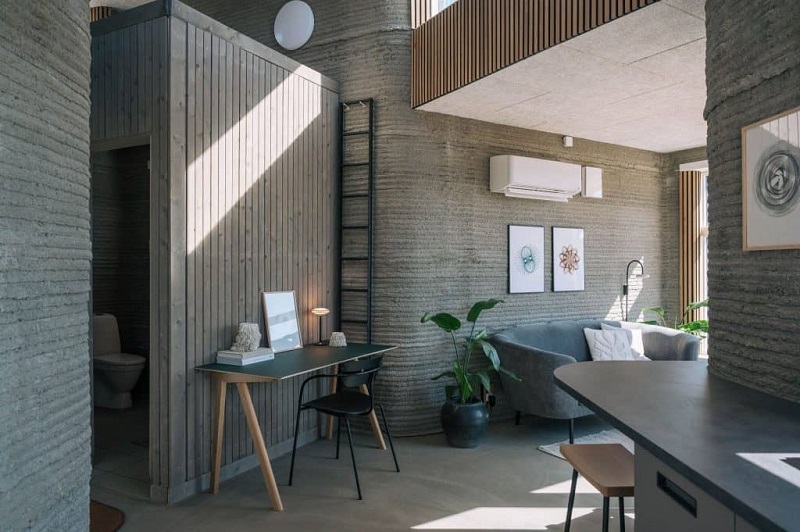
Interior view of a 3D printed home by 3DCP in Holstebro, Denmark
3D printed homes can be designed to be energy-efficient, reducing utility costs. By incorporating eco-friendly building materials, 3D printing technology promotes sustainability in residential construction.
An example of 3D-printed homes with exceptional energy efficiency is the new housing community built in partnership by Palari and Mighty Buildings in Desert Springs California. All 20 homes are slated to be Net Zero-capable, with compliance to be confirmed after one year’s worth of performance data is available.
Improved Structural Integrity
One example of improved structural integrity is Mighty Buildings. Their 3D-printed panelized frames used in the Palari Villas Scenic Crest housing community is five times stronger than concrete, with higher resistance to:
- Seismic Activity
- Wind
- Fire
- Mold
- Insects
Another example of superior structural integrity is Diamond Age. According to their website, their homes exceed Seismic B earthquake and Category 5 hurricane codes today.
A third example of enhanced structural integrity is Icon’s high-strength concrete, Lavacrete, that is said to be resistant to water, mold, termites and fire damage.
Increased Customization
The customization factor of 3D-printed homes is also an attractive feature. With advanced BIM (Building Information Modeling) and corresponding project management software, 3D-printed homes are well-suited to handle a wide-range of personalized options.
In short, you’ll be able to choose from a variety of interior finishes, plumbing, electrical wiring, insulation and more.
Reduced Labor Requirements
A lesser-known factor, that has a direct impact on new housing supply, is that the home construction industry has been losing its skilled workforce at an alarming rate over recent years. This decline has been occurring due to two critical simultaneous phenomena:
- More highly-skilled and highly-experienced workers are retiring due to age
- Fewer younger workers are choosing to enter the construction trades
That said, any technology that can help home builders operate effectively with fewer workers is of great interest. 3D construction printing has the potential to address labor shortages, while improving worker safety. This capability will equate to shorter project timelines and fewer delays.
Disadvantages of 3D-Printed Homes
Now let’s consider concerns about owning a 3D printed home. As you’ll see, the biggest disadvantage of 3D printing construction has to do with it being a new technology and a lack of data and information from the homeowner perspective.
- Unrealistic Expectations
- New Technology with Sparse Performance Data
- Non-Traditional Aesthetics
- The Unknowns of Owning a 3D-Printed Home
Unrealistic Expectations
The first disadvantage of 3D-printed homes is the high likelihood that the expectations of many prospective homebuyers may be unrealistic. Though the future is promising for 3D printing, currently only the structural walls of the first floor are typically printed for a detached residential home. A 3D-printed home may also come with certain unexpected limitations such as difficulty adding wall décor or cutting into walls for basic renovations.
According Diamond Age, 3D printing walls only automates 9% of home construction.
New Technology with Sparse Performance Data
Another significant disadvantage of 3D-printed homes is that the technology is still new and not a lot of data on performance and durability is available to quantify the reliability of the underlying materials and construction process.
With time, however, this “disadvantage” could quickly turn into an advantage, especially if a high percentage of 3D-printed homes prove to be exceptionally energy efficient. Additionally, increasing numbers of documented cases of 3D-printed homes fairing well during extreme weather events, such as hurricane winds, would spur demand for this type of home, as well.
Non-Traditional Aesthetics
Another disadvantage of 3D-printed homes has to do with aesthetics. It remains to be seen how first-generation designs of 3D-printed homes will fair in terms of resale value. If a homebuyer does not care for the rough edges of a 3D-printed home (on exterior or interior walls), this will require manual labor to smooth and require additional cost and time.
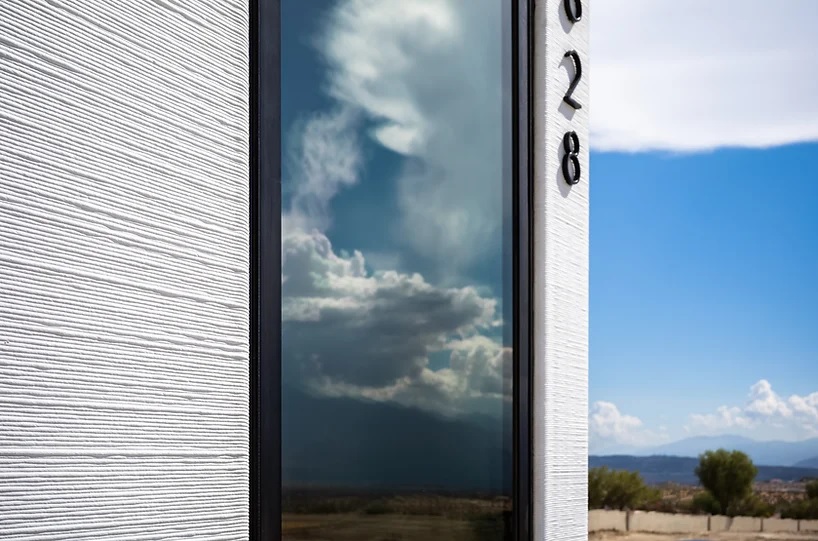
Up close view of 3D-printed panels by Mighty Buildings
The Unknowns of Owning a 3D-Printed Home
The biggest concern we would have is wondering what it is like to live in a 3D-printed home and how easy or difficult it would be to maintain it. The leading providers of 3D construction printers would be wise to start research panels of early adopter 3D-print homeowners to understand areas that need improvement or topics that require more consumer education. For example, how easy will it be for homeowners to remodel or add to the base of their 3D-printed home?
SQ4D: How to Hang a Picture on a 3D Printed Wall
3D Printed vs. Prefabricated Homes
When comparing 3D-printed homes to prefab homes, you’ll find that each approach has unique advantages depending on various factors, such as the location and accessibility of the construction site.
By understanding these advantages, some innovative home builders are leveraging a hybrid approach when necessary and feasible. So keep in mind that a 3D printed home does not have to be built exclusive of prefab construction practices.
For example, both approaches – 3D Printing and Prefabrication – are leveraging similar revolutionary construction technology such as robotics and automation.
Ever increasing efficiency has to balance what is more efficient to build in factory or on-site. In fact, one innovative firm, Diamond Age, has trademarked their unique approach to home building as “Factory On-Site”, by using 3D-printing on-site, in addition to advanced robotics. Diamond Age states that their automation platform and suite of robotic tools offset up to 27% of the manual labor required to build a conventional home. They aspire to automate 55% of conventional home construction in 2024.
Factory in the Field® | Diamond Age
3D construction printing can be used either in a factory or on-site depending on what is best for a given construction project. 3D printing can also be used for partial prefabricated structures, such as 3D-printed panels that are assembled on-site, as is done by Mighty Buildings.
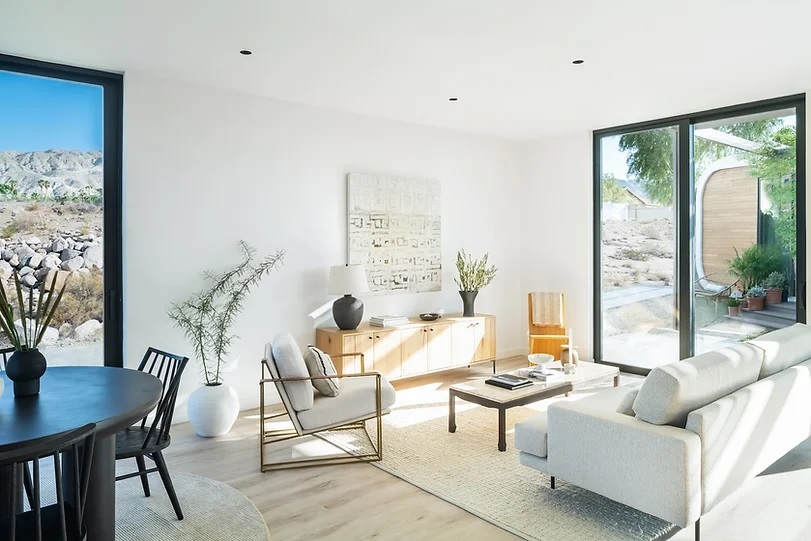
Interior view of the Palari Villa Scenic Crest that used 3D-printed panels by Mighty Buildings
Also see:
The Future of 3D Printing in Construction
The future for 3D construction printing looks promising. Innovative builders like Alquist 3D continue to receive requests for 3D-printed homes, while gaining support on the local, state, and federal levels. In fact, Alquist 3D is currently relocating to Greely, Colorado, as part of a partnership with the city and state. Their vision is to turn the area into a mecca for 3D construction. They’re beginning with residences across a broad range of price and size ranges, in addition to installing curbs around the city with integrated drainage systems.
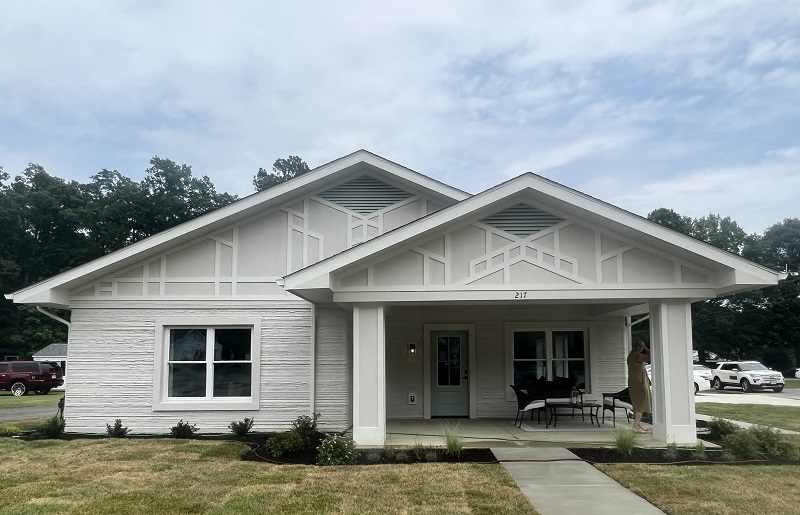
An Alquist 3D printed home
3D printing could help solve the affordable housing crisis, but there are some roadblocks. Regulations and building codes need be updated to fit the capabilities of 3D printing, and more 3D printers are needed to build more homes. Ongoing research, testing, and industry standards are also necessary to ensure the long-term structural integrity, safety, and reliability of 3D-printed homes. Despite these challenges, 3D printing can be a game-changer for affordable housing and the construction industry as a whole, as the technology evolves, new capabilities emerge and performance data is analyzed.
3D printing is one of the biggest new home innovations and shaping up to play a key role in the future of home construction. As the technology continues to improve, we can expect even more advancements in 3D printing for residential construction, ultimately changing the way we build homes. With the advantages of affordability, energy efficiency, customization, and eco-friendliness, it’s no surprise that interest is growing. If you’re looking for a more affordable and sustainable way to build a home, 3D printing could be a viable option, so keep an eye on the companies mentioned in this article!
3D Construction Printing Resources
3D Construction Printers
3D Printing Builders
- Alquist 3D
- Azure Printed Homes
- CyBe Construction
- Diamond Age
- Icon
- Nidus 3D
- Palari
- PERI
- Printed Farms
- SQ4D
- Winsun
3D Printed Homes & Communities
- Lennar Georgetown, Texas (Lennar Website)
- The Genesis Collection at Wolf Ranch (Icon Website)
- East 17th Street Residences (Icon)
- Islandia, New York (SQ4D)
- Riverhead, New York (SQ4D)
- Calverton, New York (SQ4D)
- Palari Villas Scenic Crest Desert Hot Springs (Mighty Buildings)
More Recommended Home Buying Articles
- 8 Common Mistakes Made When Budgeting for a New Home
- Green Mortgages: An Eco-Friendly Way to Combat Rising Interest Rates
- Want a Nontraditional House? Here’s How to Finance It!
- Options for Millennials Determined to Own a Home
- Enjoy Working Remotely? Here’s How to Choose to Live Wherever You Want
- Related Topics: Home Buying | Construction | Sustainability | Real Estate
| Purgula is reader-supported. When you click on links to other sites from our website, we may earn affiliate commissions, at no cost to you. If you find our content to be helpful, this is an easy way for you to support our mission. Thanks! Learn more. |






